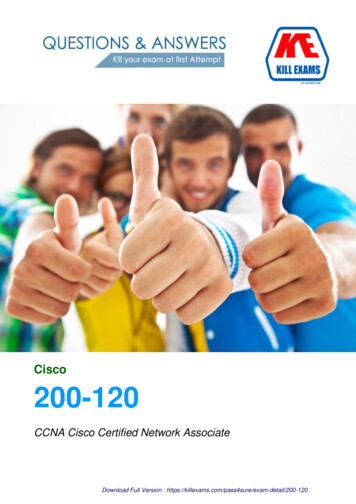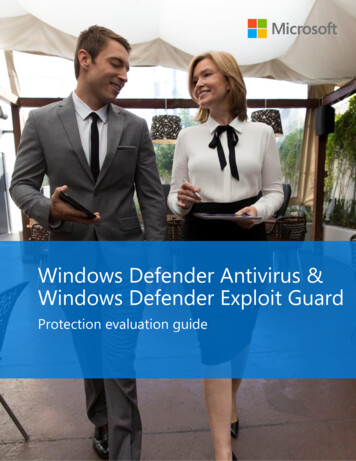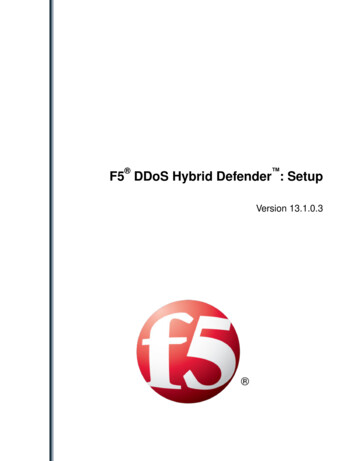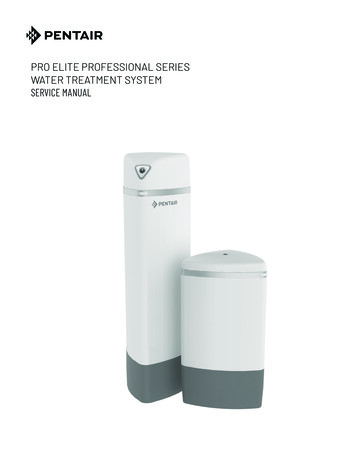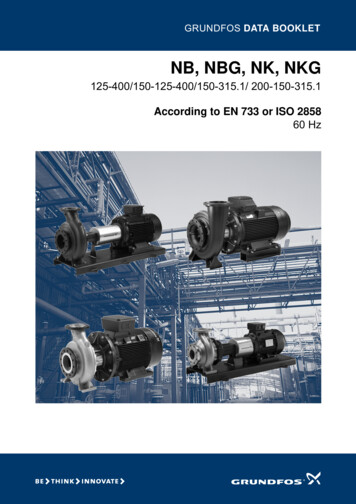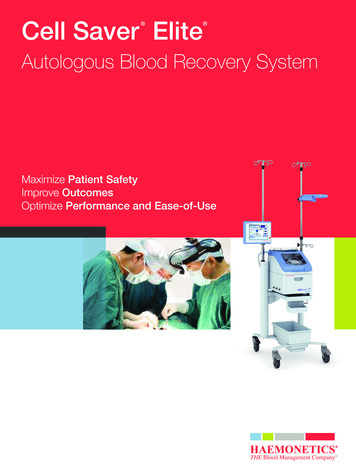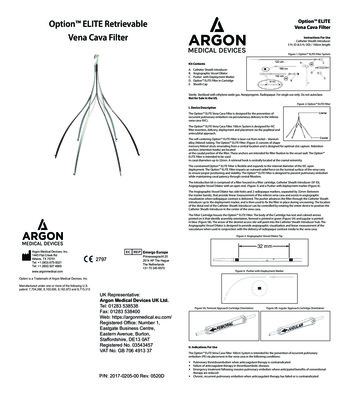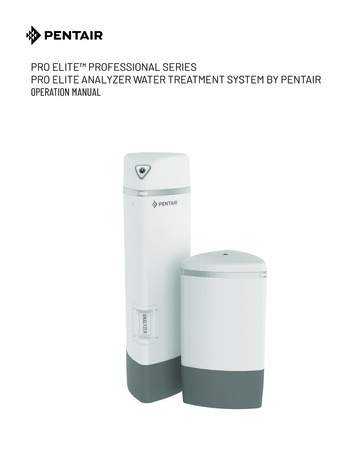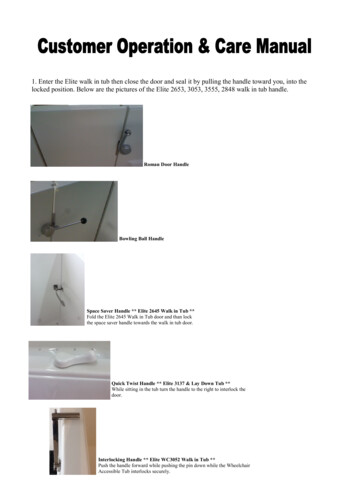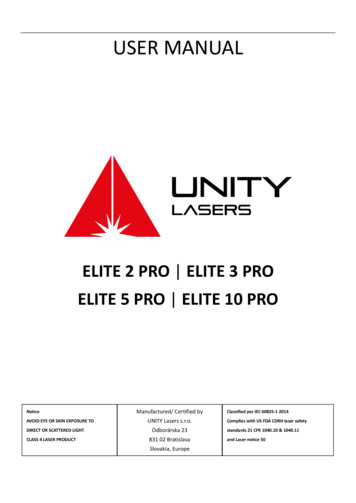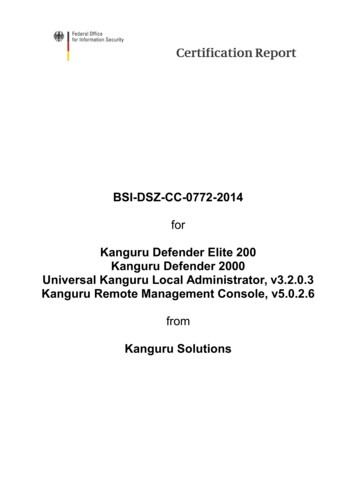
Transcription
BSI-DSZ-CC-0772-2014forKanguru Defender Elite 200Kanguru Defender 2000Universal Kanguru Local Administrator, v3.2.0.3Kanguru Remote Management Console, v5.0.2.6fromKanguru Solutions
BSI - Bundesamt für Sicherheit in der Informationstechnik, Postfach 20 03 63, D-53133 BonnPhone 49 (0)228 99 9582-0, Fax 49 (0)228 9582-5477, Infoline 49 (0)228 99 9582-111Certification Report V1.0CC-Zert-327 V5.02
BSI-DSZ-CC-0772-2014Encrypted USB Storage Device- Kanguru Defender Elite 200 with Kanguru Defender Manager Elite200, Firmware Version 02.03.10, KDME200 v2.0.0.0-2/3/6,- Kanguru Defender 2000 with Kanguru Defender Manager 2000,Firmware Version 02.03.10, KDM2000 v1.2.1.8-2/3/6,- Universal Kanguru Local Administrator, Version 3.2.0.3 and- Kanguru Remote Management Console, Version 5.0.2.6fromSOGISRecognition AgreementKanguru SolutionsPP Conformance:Common Criteria Protection Profile for USB StorageMedia, Version 1.4, 27 March 2006,BSI-PP-0025-2006Functionality:PP conformantCommon Criteria Part 2 extendedAssurance:Common Criteria Part 3 conformantEAL 2 augmented by ALC FLR.1The IT product identified in this certificate has been evaluated at an approved evaluationfacility using the Common Methodology for IT Security Evaluation (CEM), Version 3.1 forconformance to the Common Criteria for IT Security Evaluation (CC), Version 3.1.This certificate applies only to the specific version and release of the product in itsevaluated configuration and in conjunction with the complete Certification Report.The evaluation has been conducted in accordance with the provisions of the certificationscheme of the German Federal Office for Information Security (BSI) and the conclusionsof the evaluation facility in the evaluation technical report are consistent with the evidenceadduced.This certificate is not an endorsement of the IT product by the Federal Office forInformation Security or any other organisation that recognises or gives effect to thiscertificate, and no warranty of the IT product by the Federal Office for Information Securityor any other organisation that recognises or gives effect to this certificate, is eitherexpressed or implied.Common CriteriaRecognition ArrangementBonn, 7 November 2014For the Federal Office for Information SecurityBernd KowalskiHead of DepartmentL.S.Bundesamt für Sicherheit in der InformationstechnikGodesberger Allee 185-189 - D-53175 Bonn -Postfach 20 03 63 - D-53133 BonnPhone 49 (0)228 99 9582-0 - Fax 49 (0)228 9582-5477 - Infoline 49 (0)228 99 9582-111
Certification ReportBSI-DSZ-CC-0772-2014This page is intentionally left blank.4 / 42
BSI-DSZ-CC-0772-2014Certification ReportPreliminary RemarksUnder the BSIG1 Act, the Federal Office for Information Security (BSI) has the task ofissuing certificates for information technology products.Certification of a product is carried out on the instigation of the vendor or a distributor,hereinafter called the sponsor.A part of the procedure is the technical examination (evaluation) of the product accordingto the security criteria published by the BSI or generally recognised security criteria.The evaluation is normally carried out by an evaluation facility recognised by the BSI or byBSI itself.The result of the certification procedure is the present Certification Report. This reportcontains among others the certificate (summarised assessment) and the detailedCertification Results.The Certification Results contain the technical description of the security functionality ofthe certified product, the details of the evaluation (strength and weaknesses) andinstructions for the user.1Act on the Federal Office for Information Security (BSI-Gesetz - BSIG) of 14 August 2009,Bundesgesetzblatt I p. 28215 / 42
Certification ReportBSI-DSZ-CC-0772-2014ContentsA Certification.71 Specifications of the Certification Procedure.72 Recognition Agreements.73 Performance of Evaluation and Certification.94 Validity of the Certification Result.95 Publication.10B Certification Results.111 Executive Summary.122 Identification of the TOE.143 Security Policy.184 Assumptions and Clarification of Scope.195 Architectural Information.196 Documentation.217 IT Product Testing.228 Evaluated Configuration.279 Results of the Evaluation.2710 Obligations and Notes for the Usage of the TOE.2911 Security Target.2912 Definitions.2913 Bibliography.31C Excerpts from the Criteria.33CC Part 1:.33CC Part 3:.34D Annexes.416 / 42
BSI-DSZ-CC-0772-2014ACertification1Specifications of the Certification ProcedureCertification ReportThe certification body conducts the procedure according to the criteria laid down in thefollowing: Act on the Federal Office for Information Security2 BSI Certification Ordinance3 BSI Schedule of Costs4 Special decrees issued by the Bundesministerium des Innern (Federal Ministry of theInterior) DIN EN ISO/IEC 17065 standard BSI certification: Technical information on the IT security certification, ProceduralDescription (BSI 7138) [3] BSI certification: Requirements regarding the Evaluation Facility (BSI 7125) [3] Common Criteria for IT Security Evaluation (CC), Version 3.1 5 [1] also published asISO/IEC 15408. Common Methodology for IT Security Evaluation (CEM), Version 3.1 [2] also publishedas ISO/IEC 18045. BSI certification: Application Notes and Interpretation of the Scheme (AIS) [4]2Recognition AgreementsIn order to avoid multiple certification of the same product in different countries a mutualrecognition of IT security certificates - as far as such certificates are based on ITSEC orCC - under certain conditions was agreed.2.1European Recognition of ITSEC/CC – Certificates (SOGIS-MRA)The SOGIS-Mutual Recognition Agreement (SOGIS-MRA) Version 3 became effective inApril 2010. It defines the recognition of certificates for IT-Products at a basic recognitionlevel and in addition at higher recognition levels for IT-Products related to certain technicaldomains only.The basic recognition level includes Common Criteria (CC) Evaluation Assurance LevelsEAL 1 to EAL 4 and ITSEC Evaluation Assurance Levels E1 to E3 (basic). For higherrecognition levels the technical domain Smart card and similar Devices has been defined.2Act on the Federal Office for Information Security (BSI-Gesetz - BSIG) of 14 August 2009,Bundesgesetzblatt I p. 28213Ordinance on the Procedure for Issuance of a Certificate by the Federal Office for Information Security(BSI-Zertifizierungsverordnung, BSIZertV) of 07 July 1992, Bundesgesetzblatt I p. 12304Schedule of Cost for Official Procedures of the Bundesamt für Sicherheit in der Informationstechnik(BSI-Kostenverordnung, BSI-KostV) of 03 March 2005, Bundesgesetzblatt I p. 5195Proclamation of the Bundesministerium des Innern of 12 February 2007 in the Bundesanzeiger dated23 February 2007, p. 37307 / 42
Certification ReportBSI-DSZ-CC-0772-2014It includes assurance levels beyond EAL 4 resp. E3 (basic). In addition, certificates issuedfor Protection Profiles based on Common Criteria are part of the recognition agreement.As of September 2011 the new agreement has been signed by the national bodies ofAustria, Finland, France, Germany, Italy, The Netherlands, Norway, Spain, Sweden andthe United Kingdom. Details on recognition and the history of the agreement can be foundat https://www.bsi.bund.de/zertifizierung.The SOGIS-MRA logo printed on the certificate indicates that it is recognised under theterms of this agreement by the nations listed above.This certificate is recognized under SOGIS-MRA for all assurance components selected.2.2International Recognition of CC – Certificates (CCRA)The international arrangement on the mutual recognition of certificates based on the CC(Common Criteria Recognition Arrangement, CCRA-2014) has been ratified on 08September 2014. It covers CC certificates based on collaborative Protection Profiles (cPP)(exact use), certificates based on assurance components up to and including EAL 2 or theassurance family Flaw Remediation (ALC FLR) and certificates for Protection Profiles andfor collaborative Protection Profiles (cPP).The CCRA-2014 replaces the old CCRA signed in May 2000 (CCRA-2000). Certificatesbased on CCRA-2000, issued before 08 September 2014 are still under recognitionaccording to the rules of CCRA-2000. For on 08 September 2014 ongoing certificationprocedures and for Assurance Continuity (maintenance and re-certification) of oldcertificates a transition period on the recognition of certificates according to the rules ofCCRA-2000 (i.e. assurance components up to and including EAL 4 or the assurancefamily Flaw Remediation (ALC FLR)) is defined until 08 September 2017.As of September 2014 the signatories of the new CCRA are government representativesfrom the following nations: Australia, Austria, Canada, Czech Republic, Denmark, Finland,France, Germany, Greece, Hungary, India, Israel, Italy, Japan, Malaysia, The Netherlands,New Zealand, Norway, Pakistan, Republic of Korea, Singapore, Spain, Sweden, Turkey,United Kingdom, and the United States.The current list of signatory nations and approved certification schemes can be seen onthe website: http://www.commoncriteriaportal.org.The Common Criteria Recognition Arrangement logo printed on the certificate indicatesthat this certification is recognised under the terms of this agreement by the nations listedabove.As the product certified has been accepted into the certification process before 08September 2014, this certificate is recognized according to the rules of CCRA-2000, i.e.for all assurance components selected.8 / 42
BSI-DSZ-CC-0772-20143Certification ReportPerformance of Evaluation and CertificationThe certification body monitors each individual evaluation to ensure a uniform procedure, auniform interpretation of the criteria and uniform ratings.The product Kanguru Defender Elite 200 with Kanguru Defender Manager Elite 200, FirmwareVersion 02.03.10, KDME200 v 2.0.0.0-2, KDME200 v2.0.0.0-3, KDME200 v 2.0.0.0-6, Kanguru Defender 2000 with Kanguru Defender Manager 2000, Firmware Version02.03.10, KDM2000 v 1.2.1.8-2, KDM200 v1.2.1.8-3, KDM200 v1.2.1.8-6, Universal Kanguru Local Administrator, Version 3.2.0.3 and Kanguru Remote Management Console, Version 5.0.2.6has undergone the certification procedure at BSI.The evaluation of the product was conducted by atsec information security GmbH. Theevaluation was completed on 29 October 2014. atsec information security GmbH is anevaluation facility (ITSEF)6 recognised by the certification body of BSI.For this certification procedure the sponsor and applicant is: Kanguru Solutions.The product was developed by: Kanguru Solutions.The certification is concluded with the comparability check and the production of thisCertification Report. This work was completed by the BSI.4Validity of the Certification ResultThis Certification Report only applies to the version of the product as indicated. Theconfirmed assurance package is only valid on the condition that all stipulations regarding generation, configuration and operation, as given in thefollowing report, are observed, the product is operated in the environment described, as specified in the following reportand in the Security Target.For the meaning of the assurance levels please refer to the excerpts from the criteria atthe end of the Certification Report.The Certificate issued confirms the assurance of the product claimed in the Security Targetat the date of certification. As attack methods evolve over time, the resistance of thecertified version of the product against new attack methods needs to be re-assessed.Therefore, the sponsor should apply for the certified product being monitored within theassurance continuity program of the BSI Certification Scheme (e.g. by a re-certification).Specifically, if results of the certification are used in subsequent evaluation and certificationprocedures, in a system integration process or if a user's risk management needs regularlyupdated results, it is recommended to perform a re-assessment on a regular e.g. annualbasis.In case of changes to the certified version of the product, the validity can be extended tothe new versions and releases, provided the sponsor applies for assurance continuity (i.e.re-certification or maintenance) of the modified product, in accordance with the proceduralrequirements, and the evaluation does not reveal any security deficiencies.6Information Technology Security Evaluation Facility9 / 42
Certification Report5BSI-DSZ-CC-0772-2014PublicationThe product Kanguru Defender Elite 200 with Kanguru Defender Manager Elite 200, FirmwareVersion 02.03.10, KDME200 v 2.0.0.0-2, KDME200 v2.0.0.0-3, KDME200 v 2.0.0.0-6, Kanguru Defender 2000 with Kanguru Defender Manager 2000, Firmware Version02.03.10, KDM2000 v 1.2.1.8-2, KDM200 v1.2.1.8-3, KDM200 v1.2.1.8-6, Universal Kanguru Local Administrator, Version 3.2.0.3 and Kanguru Remote Management Console, Version 5.0.2.6has been included in the BSI list of certified products, which is published regularly (seealso Internet: https://www.bsi.bund.de and [5]). Further information can be obtained fromBSI-Infoline 49 228 9582-111.Further copies of this Certification Report can be requested from the developer 7 of theproduct. The Certification Report may also be obtained in electronic form at the internetaddress stated above.7Kanguru Solutions1360 Main StreetMillis, Massachusett 02054United States10 / 42
BSI-DSZ-CC-0772-2014BCertification ReportCertification ResultsThe following results represent a summary of the Security Target of the sponsor for the Target of Evaluation, the relevant evaluation results from the evaluation facility, and complementary notes and stipulations of the certification body.11 / 42
Certification Report1BSI-DSZ-CC-0772-2014Executive SummaryThe Target of Evaluation (TOE) is Kanguru Defender Elite 200 with Kanguru Defender Manager Elite 200, FirmwareVersion 02.03.10, KDME200 v 2.0.0.0-2, KDME200 v 2.0.0.0-3, KDME200 v 2.0.0.0-6, Kanguru Defender 2000 with Kanguru Defender Manager 2000, Firmware Version02.03.10, KDM2000 v 1.2.1.8-2, KDM2000 v 1.2.1.8-3, KDM2000 v 1.2.1.8-6, Universal Kanguru Local Administrator, Version 3.2.0.3 and Kanguru Remote Management Console, Version 5.0.2.6.The TOE provides protected USB mass storage. Its purpose is to protect the contents ofthe mass storage from unauthorized access, in case the locked storage device falls intothe hands of unauthorized entities.The USB device can be managed locally via the Universal Kanguru Local Administrator(KLA) or centrally, using the Kanguru Remote Management Console (KRMC). The KRMCallows a central administrator to control the devices in an enterprise environment.Depending on the communication capabilities desired, the USB device is available withthree different versions of the Kanguru Defender Manager (KDM 8). The KDM/E version isidentified by the version number suffix as follows: -2 (cloud version), -3 (enterprise version)or -6 (standalone version).The protection of the user data is the major security function of the TOE. The mechanismof the protection is the complete encryption of the user data via AES-256 in CBC-mode. Itsdecryption, i.e. the device unlock, will only be performed if the user provides the correctpassword. The data protection is also robust against external disruptions, like a systemcrash or the power being disconnected.When a master password is set for the device, an administrator can reset or change theuser password. Resetting the user password also means deleting the user data. If amaster password is to be used, it needs to be set before the user password. Otherwise,the user password will be wiped, resulting in the deletion of the user data.The device hardware internals are covered in epoxy to provide a physical tamperingprotection in a way that the user will be able to detect when a tampering attempt hasoccurred.The Security Target [6] is the basis for this certification. It is based on the certifiedCommon Criteria Protection Profile for USB Storage Media, Version 1.4, 27 March 2006,BSI-PP-0025-2006 [7].The TOE Security Assurance Requirements (SAR) are based entirely on the assurancecomponents defined in Part 3 of the Common Criteria (see part C or [1], Part 3 for details).The TOE meets the assurance requirements of the Evaluation Assurance Level EAL 2augmented by ALC FLR.1.The TOE Security Functional Requirements (SFR) are outlined in the Security Target [6],chapter 6.2. They are selected from Common Criteria Part 2 and some of them are newlydefined. Thus the TOE is CC Part 2 extended.8For Kanguru Defender Elite 200, the client application is called Kanguru Defender Manager Elite (KDME).12 / 42
BSI-DSZ-CC-0772-2014Certification ReportThe TOE Security Functional Requirements are implemented by the following TOESecurity Functionality:TOE Security FunctionalityAddressed issueUser data protectionUser data on the encrypted mass storage of the USB device isprotected from access when the device is locked and it canonly be unlocked with the user password.All user data is stored in encrypted form, using a unique key(created via the random number generator on the device atdevice initialization) that is stored only on the cryptographicchip of the TOE. Only when unlocked via the user or masterpassword, can the data be accessed and decrypted. Theencrypted data is never accessible.When a master password is set, it can be used to set a newuser or master password and to access the protected data. Ifthe physical or logical connection of the unlocked device isbroken, authentication is required again. The password qualityhas to be set according to the Evaluated Product User Guide[9], chapter 9. Brute force attacks from the client areadditionally mitigated by rate limiting the password attempts to1/s on the device.TSF data protectionThe encryption key for the protected data is stored on thedevice and is protected against unauthorized access. Nointerface exists, to extract the encryption key from within thecryptographic chip. This leaves only the potential of physicalattacks.Physical attacks are blocked by the resilient nature of theTOE, as the device always returns to a locked state in case ofdisruptions. Additionally, the TSF enforcing chips are coated inepoxy to ensure that tamper attempts can be easily detected.Local and remote managementLocal administration can be performed by KLA, remotemanagement via the KRMC. To use the KLA, an administratorfirst needs to authenticate via password. To use the KRMC, anadministrator first needs to authenticate via his user ID andpassword. The KDM/E client is used to rely commands fromthe KRMC to the device.A managed device can be explicitly reset by the administrator,resulting in the deletion of the encrypted data by overwritingthe encryption key with a new one. Devices can also beexplicitly reset by anyone with physical access.The administrator can change his password at KLA or KRMCif needed. An administrator can trigger a reset of the userpassword, forcing the user to set a new one afterauthentication. If a master password is set, then theadministrator can also change the users' password via KLA orKRMC. If a master password is to be used, it needs to be setby the administrator before the user password is set by theuser. If a master password is set after a user password hasbeen set, the user password will be wiped, which is equivalentto deleting the protected storage.Table 1: TOE Security FunctionalitiesFor more details please refer to the Security Target [6], chapter 7.1.13 / 42
Certification ReportBSI-DSZ-CC-0772-2014The assets to be protected by the TOE are defined in the Security Target [6], chapter 3.2 .Based on these assets the TOE Security Problem is defined in terms of Assumptions,Threats and Organisational Security Policies. This is outlined in the Security Target [6],chapter 3.This certification covers the configurations of the TOE as outlined in chapter 8.The vulnerability assessment results as stated within this certificate do not include a ratingfor those cryptographic algorithms and their implementation suitable for encryption anddecryption (see BSIG Section 9, Para. 4, Clause 2).The certification results only apply to the version of the product indicated in the certificateand on the condition that all the stipulations are kept as detailed in this CertificationReport. This certificate is not an endorsement of the IT product by the Federal Office forInformation Security (BSI) or any other organisation that recognises or gives effect to thiscertificate, and no warranty of the IT product by BSI or any other organisation thatrecognises or gives effect to this certificate, is either expressed or implied.2Identification of the TOEThe Target of Evaluation (TOE) is called: Kanguru Defender Elite 200 with Kanguru Defender Manager Elite 200, FirmwareVersion 02.03.10, KDME200 v 2.0.0.0, Kanguru Defender 2000 with Kanguru Defender Manager 2000, Firmware Version02.03.10, KDM2000 v 1.2.1.8, Universal Kanguru Local Administrator, Version 3.2.0.3 andKanguru Remote Management Console, Version 5.0.2.6.The following table outlines the TOE deliverables:NoTypeIdentifierReleaseForm of Delivery1HWKanguru Defender Elite 200-Postal2HWKanguru Defender 2000-Postal3SWKanguru Defender Elite 200 Firmware02.03.10on Hardware4SWKanguru Defender 2000 Firmware02.03.10on Hardware5SWKanguru Defender Manager Elite 200 Client2.0.0.0-2/3/6 on Hardware orDownload6SWKanguru Defender Manager 2000 Client1.2.1.8-2/3/6 on Hardware orDownload7SWUniversal Kanguru Local AdministratorSHA-256 f3bacc6e661acefa1134ae93.2.0.3CD or Download8SWKanguru Remote Management Console5.0.2.6SHA-256 a068b886bf938bf58366789CD or Download14 / 42
BSI-DSZ-CC-0772-2014Certification ReportNoTypeIdentifierReleaseForm of Delivery9DOCEvaluated Product User Guide [9]SHA-256 76c4bbe95a143fd15b974d61.20Download10DOCKanguru Defender Elite 200 User Manual [10]SHA-256 f6389e0a4aab39d3f75189c1.1Download11DOCKanguru Defender 2000 User Manual [11]1.1.4SHA-256 e4f9a65cde796de0d4e0d76Download12DOCUniversal Kanguru Local Administrator User Manual [12] 3.2.1SHA-256 b937cd1f62f355dbcb9af65Download13DOCKRMC Administrator's User Manual [13]5.0.2SHA-256 fc3e2a8dd4639ed1b3547ceDownloadTable 2: Deliverables of the TOEThe USB device is delivered to the customer with a seal on the package, with theguidance requiring the user to verify that the seal is not broken. The USB device comespreloaded with the firmware. There are three delivery scenarios for the KDM/E clientsoftware: Customers (after a separate agreement with the developer) may get the devicepreinstalled with the CC-certified client software. The delivered device does not contain the CC-certified client software. The softwaretherefore has to be updated to the CC-certified version using the downgrader applicationfrom the developer support site. The device, with a non-CC-certified KDM/E version installed, has already been usedsome time and therefore has to be migrated to the CC-certified version. For this, thedevice has to be updated as described in the second delivery scenario.For the second and third scenario, the user has to verify that the device has not beentampered with before using it in the CC-evaluated configuration. For this, the followingchecks and operations must be performed: Reset the device. Check the checksum of the downgrader application. Check the checksum of the files on the device after the downgrade has been performed.The SHA-256 checksum values for the application files after downgrading to the certifiedTOE version are provided in the two tables below (for KDME 200 and KDM 2000respectively) and in Chapter 11 of the Evaluated Product User Guide [9].15 / 42
Certification ReportBSI-DSZ-CC-0772-2014File ces\KDMElite.icns mpty.lproj-Standard/Cloud Version 2.0.0.0-2Standard/Cloud (2.0.0.0-2) 2b005313b65f66f57c4aee6d8bb2version.ini (on f0372e95b0ec86ada0a5ac8version.ini (after dac15cc9fe99ca402cc241a5517923Enterprise Version 2.0.0.0-3Enterprise (2.0.0.0-3) 6710e43ccaa2f2efca53fa85e49bversion.ini (on edef6e04f2678d6b054e272version.ini (after 0cd75df5958c63326cf7993341b2f6No-Comms Version 2.0.0.0-6No-Comms (2.0.0.0-6) 990d343597edac9c7bf83c9bb16 / 42
BSI-DSZ-CC-0772-2014Certification ReportFile b78b29f2e3b749a8f405c0d2version.ini (on e403f335199443298fa8110version.ini (after 5be0e4f6aea8837de657d3f631c9f1Table 3: SHA-256 checksums for KDME 200 ClientFile 6ca8e0740b9eeab2dd4676c2kdm2000 ty.lproj-Standard/Cloud Version 1.2.1.8-2Standard/Cloud (1.2.1.8-2) 445897f247
The CCRA-2014 replaces the old CCRA signed in May 2000 (CCRA-2000). Certificates based on CCRA-2000, issued before 08 September 2014 are still under recognition according to the rules of CCRA-2000. For on 08 September 2014 ongoing certification procedures and for Assurance Continuity (maintenance and re-certification) of old
